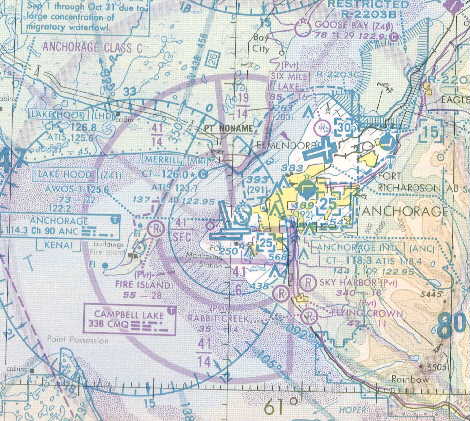 |
|||||
| Home | Research | For Teachers | HISTORY Level 1 Level 2 Level 3 |
PRINCIPLES Level 1 Level 2 Level 3 |
CAREER Level 1 Level 2 Level 3 |
| Gallery | Hot Links | What's New! | |||
| Web Administration and Tools | |||||
 |
|||||
| Home | Research | For Teachers | HISTORY Level 1 Level 2 Level 3 |
PRINCIPLES Level 1 Level 2 Level 3 |
CAREER Level 1 Level 2 Level 3 |
| Gallery | Hot Links | What's New! | |||
| Web Administration and Tools | |||||

Before World War II, airspace in the United States was not a major concern, since the
number of aircraft flying was relatively small. With the number of aircraft flying over
the United States today, proper airspace usage is critical for flight safety and efficient
service to pilots and the flying public. To assist in this goal, the airspace is divided
into five classifications.
CLASS A Airspace
Class A Airspace is the airspace from FL 180 or 18,000 feet to FL 600 or 60,000. All
pilots flying in Class A airspace shall file an Instrument Flight Rules (IFR) flight plan
and receive an appropriate air traffic control (ATC) clearance. When climbing through
18,000 feet, the pilot will change the altimeter setting from the local altimeter
(30.01 for example) to 29.92. This ensures all aircraft flying in class A airspace have
the same altimeter setting and will have proper altitude separation.
CLASS B Airspace
Class B Airspace is generally the airspace from the surface to 10,000 feet. This airspace
is normally around the busiest airports in terms of aircraft traffic such as Chicago or
Los Angeles. Class B airspace is individually designed to meet the needs of the particular
airport and consists of a surface area and two more layers. Most Class B airspace resemble
an upside down wedding cake. Pilots must contact air traffic control to receive an air
traffic control clearance to enter Class B airspace. Once a pilot receives an air traffic
control clearance, they receive separation services from other aircraft within the
airspace.
CLASS C Airspace
Class C Airspace is the airspace from the surface to 4,000 feet above the airport
elevation. Class C airspace will only be found at airports that have an operational
control tower, are serviced by a radar approach control, and that have a certain number of
IFR operations. Although Class C airspace is individually tailored to meet the needs of
the airport, the airspace usually consists of a surface area with a 5 nautical mile (NM)
radius, an outer circle with a 10 NM radius that extends from 1,200 feet to 4,000 feet
above the airport elevation and an outer area. Pilots must establish and maintain two-way
radio communications with the ATC facility providing air traffic control services prior to
entering airspace. Pilots of visual flight rules (VFR) aircraft are separated from pilots
of instrument flight rules (IFR) aircraft only. Anchorage International airport, located
in Anchorage, Alaska, has a Class C airspace.
CLASS D Airspace
The fourth airspace is Class D Airspace which is generally that airspace from the surface
to 2,500 feet above the airport elevation. Class D airspace only surrounds airports that
have an operational control tower. Class D airspace is also tailored to meet the needs of
the airport. Pilots are required to establish and maintain two-way radio communications
with the ATC facility providing air traffic control services prior to entering the
airspace. No separation services will be provided to pilots of VFR (Visual Flight Rules)
aircraft. Pilots operating under VFR must still use "see-and-avoid" for aircraft
separation. Airports without operating control towers are uncontrolled airfields. Here
pilots are responsible for their own separation and takeoff and landings. Uncontrolled
airports use a "UNICOM" frequency that pilots will transmit their intentions to
other aircraft using the airport. EXAMPLE: "CESSNA 1870 VICTOR (the aircraft's
callsign) DEPARTING UNION CITY (the uncontrolled airport) RUNWAY 17 (the pilot's
intentions).
CLASS E Airspace
The fifth airspace to discuss is Class E Airspace which is generally that airspace that is
not Class A, B, C, or D. Class E airspace extends upward from either the surface or a
designated altitude to the overlying or adjacent controlled airspace. If an aircraft is
flying on a Federal airway below 18,000 feet, it is in Class E airspace. Class E airspace
is also the airspace used by aircraft transiting to and from the terminal or en route
environment normally beginning at 14,500 feet to 18,000 feet. Class E airspace ensures IFR
aircraft remain in controlled airspace when approaching aircraft without Class D airspace
or when flying on "Victor airways" -- federal airways that are below 18,000
feet. NOTE: VFR aircraft can fly up to 17,500 feet IF they can maintain VFR weather
clearance criteria (and the aircraft is equipped to fly at 17,500 feet).
CLASS G Airspace
Class G Airspace is uncontrolled airspace. IFR aircraft will not operate in Class G
airspace. VFR aircraft can operate in Class G airspace.
Chart of Anchorage, Alaska airspace

Send all comments to ![]() aeromaster@eng.fiu.edu
aeromaster@eng.fiu.edu
© 1995-98 ALLSTAR Network. All rights reserved worldwide.
| Funded in part by | Used with permission From 90th Fighter Squadron "Dicemen" Aviation |
Updated: February 24, 1999